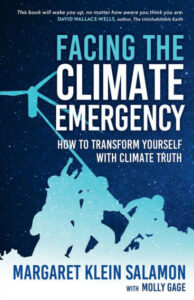 Is it good to feel fear? Is it good to feel anger? These are emotions that society frowns on, mostly, and we learn to repress, suppress, deny or dissociate from them.
Is it good to feel fear? Is it good to feel anger? These are emotions that society frowns on, mostly, and we learn to repress, suppress, deny or dissociate from them.
In her book, Facing the Climate Emergency, Margaret Klein Salamon writes that she believes that fear and anger are not only good, but absolutely necessary when thinking about the climate emergency that is affecting every living thing on the planet. Necessary, because it is only by internalizing our fears and anger over what humans are doing to Earth that we will be energized and committed to taking direct action—action unrelenting—in order to not only stop, but actually reverse, the climate devastation we see around us.
Salamon uses the example of responding to a fire alarm: we may not be aware of an alarm sounding until those around us who are aware begin to move in the direction of safety. Then, our awareness pricked, we may hear the alarm and begin to smell the smoke and begin to identify the place from which it is coming. We respond by following those who became aware before us with an urgency borne of self-preservation. Some will use an extinguisher or hose; others will flee to safety and others will try to help others who may be less able to cope with the situation at hand.
In a climate emergency, however, there is no safety. Salamon urges—demands—that you and I react to the climate emergency in the same way, as though our lives depend on our individual and collective responses, because they do.
Salamon quotes many persons from fields as diverse (but interrelated) as philosophy, religion, science, psychology, politics, and education, and she presents as an exemplar the AIDS activist movement, which mobilized gay men to force governments around the world to make legislative changes to protect them from scourges like the disease, and prejudice.
This book was published before the scourge of the coronavirus spread like a wildfire over the earth, and before the frank acknowledgement of racial prejudice after the death of George Floyd led to the validation of the Black Lives Matter movement.
From the United States experience, we see a government willingly complicit in avoiding a national legislative response to both the virus and racial prejudice. This is borne out, for example, in the mixed message regarding the wearing of masks (my spoiler alert: wear a mask in public!), and by our president retweeting a video of a white supremacist shouting, “White Power” to the cameras recording a demonstration.
Collectively, Americans who are woke to these crises are taking their own action on mask-wearing because we are aware that this action saves lives, and are supportive of increased police regulation and the removal of Confederate monuments. This is the same type of collective response that Salamon writes about, and it could not be more timely than this immediate moment!
The sub-title of this slim, provocative book is “How to Transform Yourself With Climate Truth.” It is a workbook. Each of the five steps Salamon provides us comes with questions which the reader, individually or in a group setting, can consider during the transformation. These range from reflections on fear and anger, but also love of oneself, others, and the planet. Our relationship to things and acquisition, and self-worth; the needs we have which relate to living fully and acting fully on the problems we recognize as our present reality; considering our nascent ability to, or
experiences in, speaking truth to power; and ways to take ACTION (beside reading this review, or better, Solaman’s book), are integral to the book’s purpose.
This book will help those who are angry and fearful—and loving—enough to find answers for ourselves as to what actions to take… what actions MUST be taken, to restore the Earth to ecological balance. Fortunately, Salamon has one clear answer for us: step up to the Climate Mobilization Project, an organization she created to mobilize a World War II-type response, a dramatic and thorough endeavor where so many individuals made so many sacrifices and life-changes to bring a peace to the world.
So committed is Salamon to the belief that change is possible through mobilization that one can obtain the first chapter of her book at no charge: Visit the website, hover on “Resources,” then click on “Our Book,” or click here.









